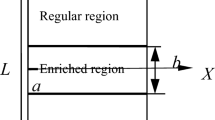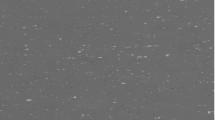Abstract
Ubiquitiform geometry, as an important tool to study complex and irregular configurations, provides an important theoretical basis for solving nonlinear problems. In this paper, considering the ubiquitiformal characteristics of crack propagation, two key ubiquitiformal parameters of complexity and yardstick length were introduced into the theoretical derivation of Mode I crack propagation. The effects of complexity on the stress intensity factor and crack propagation forces were also analyzed using numerical examples. Furthermore, the uniaxial tensile failure behavior of cast iron materials under different crack forms was studied. The fracture surface morphology of a tensile specimen was measured using a laser confocal microscope, and the complexity of cross-section contours and the statistical self-similar interval was calculated via the box-counting method. Experimental results verified the accuracy of the expression of ubiquitiform critical stress. It is demonstrated that ubiquitiform theory fundamentally solves the difficulties in application of fractal theory. More rational results can be obtained when ubiquitiform fracture parameters are adopted in fracture problems.









Similar content being viewed by others
References
Carpinteri, A., Spagnoli, A.: A fractal analysis of size effect on fatigue crack growth. Int. J. Fatigue 26(2), 125–133 (2004)
Carpinteri, A., Spagnoli, A., Vantadori, S.: A multifractal analysis of fatigue crack growth and its application to concrete. Eng. Fracture Mech. 77(6), 974–984 (2010)
Yavari, A., Sarkani, S., Moyer, E.T.: The mechanics of self-similar and self-affine fractal cracks. Int. J. Fract. 114(1), 1–27 (2002)
Wnuk, M.P., Yavari, A.: On estimating stress intensity factors and modulus of cohesion for fractal cracks. Eng. Fract. Mech. 70(13), 1659–1674 (2003)
Kashtanov, A., Petrov, Y.: Fractal models in fracture mechanics. Int. J. Fract. 128, 271–276 (2004)
Liu, A.Z., Wang, T., Zhang, S.: The analysis of 16MnR steel compact tensile fatigue fracture after high temperature. Appl. Mech. Mater. 253–255, 341–344 (2013)
Saouma, V.E., Barton, C.C., Gamaleldin, N.A.: Fractal characterization of fracture surfaces in concrete. Eng. Fract. Mech. 35(90), 47–53 (1990)
Krohn, C.E., Thompson, A.H.: Fractal sandstone pores: Automated measurements using scanning-electron-microscope images. Phys. Rev. B 33(9), 6366–6374 (1986)
Chen, C., Runt, J.: Fractal analysis of polystyrene fracture surfaces. Polym. Commun. 30(11), 334–335 (1989)
Saouma, V.E., Barton, C.C.: Fractals, fractures, and size effects in concrete. J. Eng. Mech. 120(4), 835–854 (1994)
Mu, Z.Q., Lung, C.W.: Studies on the fractal dimension and fracture toughness of steel. J. Phys. D Appl. Phys. 21(5), 848–850 (1988)
Carpinteri, A.: Fractal nature of material microstructure and size effects on apparent mechanical properties. Mech. Mater. 18(2), 89–101 (1994)
Xie, H.: Fractal effect of irregularity of crack branching on the fracture toughness of brittle materials. Int. J. Fract. 41(4), 267–274 (1989)
Pande, C.S., Richards, L.E., Louat, N., et al.: Fractal characterization of fractured surfaces. Acta Metallurgica 35(7), 1633–1637 (1987)
Ray, K.K., Mandal, G.: Study of correlation between fractal dimension and impact energy in a high strength low alloy steel. Acta Metallurgica Et Materialia 40(3), 463–469 (1992)
Charkaluk, E., Bigerelle, M., Iost, A.: Fractals and fracture. Eng. Fract. Mech. 61(1), 119–139 (1998)
Nagahama, H.: A fractal criterion for ductile and brittle fracture. J. Appl. Phys. 75(75), 3220–3222 (1994)
Ou, Z.C., Li, G.Y., Duan, Z.P.: Concept of ubiquitiform in applied nonlinear science. Acta Armamentarii 33, 261–266 (2012). (in Chinese)
Ou, Z.C., Li, G.Y., Duan, Z.P., Huang, F.L.: Ubiquitiform in applied mechanics. J. Theor. Appl. Mech. 52(1), 37–46 (2014)
Li, G.Y., Ou, Z.C., Xie, R., Duan, Z.P., Huang, F.L.: A ubiquitiformal one-dimensional steady-state conduction model for a cellular material rod. Int. J. Thermophys. 37, 41 (2016)
Li, J.Y., Ou, Z.C., Tong, Y., Duan, Z.P., Huang, F.L.: A statistical model for ubiquitiformal crack extension in quasi-brittle materials. Acta Mech. 228(7), 2725–2732 (2017)
Ou, Z.C., Yang, M., Li, G.Y., Duan, Z.P., Huang, F.L.: Ubiquitiformal fracture energy. J. Theor. Appl. Mech. 55(3), 1101–1108 (2017)
Wnuk, M.P., Yavari, A.: A correspondence principle for fractal and classical cracks. Eng. Fract. Mech. 72(18), 2744–2757 (2005)
Borodich, M.E.: Some fractal models of fracture. J. Mech. Phys. Solids 45(2), 239–259 (1997)
Carpinteri, A., Puzzi, S.: Self-similarity in concrete fracture: size-scale effects and transition between different collapse mechanisms. Int. J. Fract. 154(1–2), 167–175 (2008)
Carpinteri, A., Paggi, M.A.: A unified fractal approach for the interpretation of the anomalous scaling laws in fatigue and comparison with existing models. Int. J. Fract. 161(1), 41–52 (2010)
Baran, G.R., Roques-Carmes, C., Wehbi, D., et al.: Fractal characteristics of fracture surfaces. J. Am. Ceram. Soc. 75(10), 2687–2691 (1992)
Huang, Z.H., Tian, J.F., Wang, Z.G.: Comments on some of the fractal equations. Mater. Sci. Eng. A Struct. Mater. Prop. Microstruct. Process. 128(2), L13–L14 (1990)
Xie, H.P., Wang, J.A.: Direct fractal measurement of fracture surfaces. Int. J. Solids Struct. 36(20), 3073–3084 (1999)
Silva, P.M., Florindo, J.B.: A statistical descriptor for texture images based on the box counting fractal dimension. Physica A Stat. Mech. Appl. 528, 121469 (2019). https://doi.org/10.1016/j.physa.2019.121469
So, G.B., So, H.R., Jin, G.G.: Enhancement of the Box-Counting Algorithm for fractal dimension estimation. Pattern Recognit. Lett. 98, 53–58 (2017)
Mosolov, A.B.: Mechanics of fractal cracks in brittle solids. Europhys. Lett. (EPL) 24(8), 673–678 (1993)
Acknowledgements
This work was supported by the Fund for the National Security Academic Fund (NSAF) (Grant Numbers U1630144); and the National Natural Science Foundation of China (Numbers 11872300, 11572244, 11972285).
Author information
Authors and Affiliations
Corresponding author
Additional information
Publisher's Note
Springer Nature remains neutral with regard to jurisdictional claims in published maps and institutional affiliations.
Rights and permissions
About this article
Cite this article
Shi, J., Zhang, N., Cao, X. et al. Characterization of ubiquitiform crack fracture parameters based on ubiquitiform theory. Acta Mech 231, 2589–2601 (2020). https://doi.org/10.1007/s00707-020-02642-6
Received:
Revised:
Published:
Issue Date:
DOI: https://doi.org/10.1007/s00707-020-02642-6




